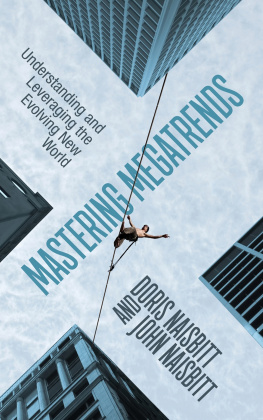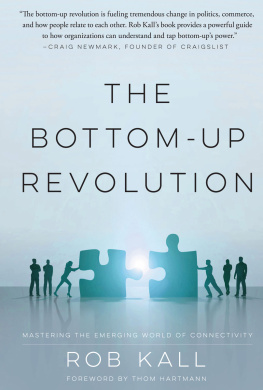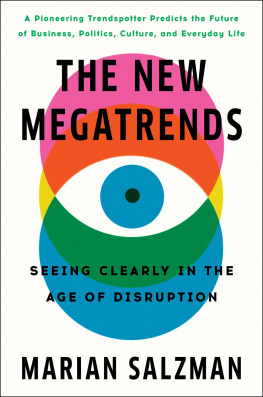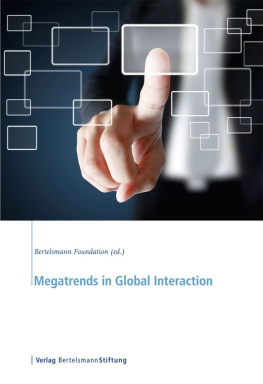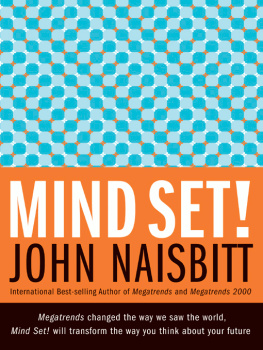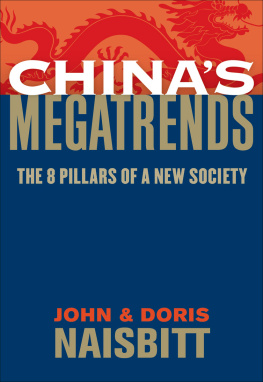
MASTERING MEGATRENDS
MASTERING MEGATRENDS
Understanding and Leveraging the Evolving New World
Doris Naisbitt and John Naisbitt

Exclusive to and approved by the estate of Joseph Murphy

Published 2019 by Gildan Media LLC
aka G&D Media
www.GandDmedia.com
MASTERING MEGATRENDS. Copyright Joseph Murphy Trust. All rights exclusively licensed by JMW Group Inc., .
No part of this book may be used, reproduced or transmitted in any manner whatsoever, by any means (electronic, photocopying, recording, or otherwise), without the prior written permission of the author, except in the case of brief quotations embodied in critical articles and reviews. No liability is assumed with respect to the use of the information contained within. Although every precaution has been taken, the author and publisher assume no liability for errors or omissions. Neither is any liability assumed for damages resulting from the use of the information contained herein.
Front cover design by David Rheinhardt of Pyrographx
Interior design by Meghan Day Healey of Story Horse, LLC
Library of Congress Cataloging-in-Publication Data is available upon request
ISBN: 978-1-7225-0282-9
eISBN: 978-1-7225-2386-2
10987654321
Contents
Introduction
How Thoughts Became a Book
E ver since Megatrends was published in 1982, the question we have most been asked is What is the next megatrend?
Almost everyone, including us, would like to have a map, which would help us outline our path into a predictable environment called future. And with more or less imagination and interpretation information available allows us to draft a more or less accurate picture of what will be. The impact and success of Megatrends was based on helping people to sort our things they were mostly familiar with. And in due course take the single pieces of the presence and form a picture of the future. At that time it guided readers through the transformation America would undergo in the 1980s and 1990s.
Looking back to Megatrends 1982 it is not hard to see how its insights helped people to ride the trends in the direction they were already going. The move from an industrial society to an information age, the most significant and most influential of the ten Megatrends outlined in that book, was well on its way and had already started to influence production, labor markets, communication, entertainment, and social life. The stories people tell about the impact of reading Megatrends have one thing in common: the book helped them recognize ten trends that were already unfolding. The book made clearer what they had sensed to some degree: Megatrends helped me to put the pieces of the puzzles together.
Megatrends 1982: Good News for All
Even though Megatrends was written based on developments in the United States and for the United States, people in other parts of the world (Megatrends was published in 57 countries) could benefit. The individual trends were making their way from the West to the other parts world. Readers followed the thoughts and reviewed and updated their own thinking. Getting clarity helped students, employees, and entrepreneurs to plan their careers and business strategies.
The transformation Megatrends described was fundamental, but it was a continuation of developments that were already at work, though not obvious. In most regards it was pursuing something that was already in place, but was not a complete rethinking. In most cases the change was welcome. And most important, the driver of change was and would remain the United States. Easy to accept for any American but also easy to embrace for Asians, especially the Chinese, as their orientation for progress and learning at that time was towards the West, mainly America. Even Western Europe, which never had too humble a mindset, accepted Americas lead. Megatrends 1982 was good news for all.
In the 30 plus years since Megatrends was published, the manifestations of the described trends became more obvious and the speed of implementation accelerated. During those decades as author and co-authors, we have dealt with the developments outlined in Megatrends in greater detail. Megatrends Asia described the economic rise of Asia; High Tech High Touch elaborated on the unintended consequences of the information age; Chinas Megatrends was about the pillars on which China, the challenger of the leading global role of the West, was resting and building. Global Game Change, first published in 2015 in China, dealt mostly with geopolitical change. Many of the developments had already been anticipated with more or less clarity in Megatrends.
New Megatrends Arising
The question of what the next megatrends would be remained. But trends cannot be forced to appear; most so-called trends are fads coming and going. Megatrends do not come every second year. All you can do is keep your eyes open, and thats what we did. And slowly, as we were traveling and observing the world, something seemed to move. It started as an indefinable feeling. Something was in the air. We could not quite capture it, but we felt that it was something profound.
We started our research to get clarity on what was really changing. After a while we sensed that many of the developments had parallels with the reformation of the 15th century. The Reformation of the 15th century over time led to modernity, the rise of the West and the world order we have lived with for the last 200 years. We started a manuscript and chose Global Reformation as its working title. As we went along we understood that just as in the historic reformation it was also a time holding great opportunities. So our working title changed to The Great Opening Up. We continued our research and, as it happens when you are very deep into a subject, one day it became clear to us: This is not just describing new megatrends. What we are witnessing is the path to a complete change of the global game. Not as the transformation described in Megatrends in 1982, finding its way from the U.S. to the world, but parallel shifts involving countries on almost every continent and taking place in various fields and directions, feeding into each other, connected politically, economically, and technologically. As in the 15th century, the change we are witnessing will result in a new world order.
A New World Order
Our first approach, to compare the transformation to the 15th century reformation had pointed us in the right direction. In the 15th century, the invention of mechanical movable type led to a communication revolution and changed education from being accessible only to an elite to becoming accessible to the masses. Cities were growing and affluence among commoners rising. But most important was the beginning of the fading hegemony of the Catholic Church. In our days, the parallel to the printing press, the Internet, enables millions to connect, communicate, and influence. Individuals and businesses no longer operate independently in their field of endeavor and within limited geographic areas but are integrated parts of global developments.
Beginning with the Renaissance in Italy, enforced by the Reformation in the 16th century the political influence of the Catholic Church and its control over education and science diminished. Until then the earth was taught to be the center of the universe, just as the Pope and Rome were the center of religion. Scientists were standing up against the wisdom of thousands of years: the belief that the sun revolved around the earth. The shift from the geocentric to the heliocentric world view did not directly change the life of the average person, but it had comprehensive consequences, leading to an explosion of scientific breakthroughs opening thitherto shuttered opportunities. Nevertheless it took almost 400 more years before Darwin questioned the last domain of the Church, our divine origin.
Next page
